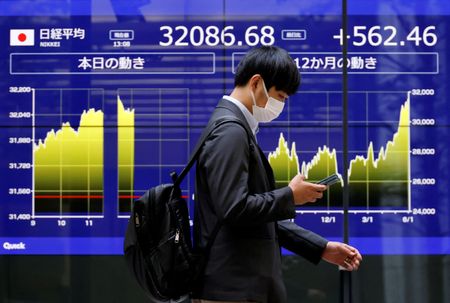
By Ankur Banerjee
SINGAPORE (Reuters) – Asian shares rose to a four-month high on Friday as U.S. economic data stoked expectations that the Federal Reserve is near the end of its rate-hike campaign, while the yen fell after the Bank of Japan maintained its ultra-easy monetary policy.
MSCI’s broadest index of Asia-Pacific shares outside Japan was 0.4% higher and on course for 2.5% gain in the week, its best weekly performance since January.
But futures indicated European markets were set for a more subdued start, with the Eurostoxx 50 futures down 0.09%, German DAX futures down 0.04% and FTSE futures down 0.03%. E-mini futures for the S&P 500 fell 0.22%.
The BOJ rounded up a central bank heavy week, keeping its pledge to “patiently” sustain massive stimulus to ensure Japan sustainably achieves its 2% inflation target accompanied by wage hikes.
As widely expected, the BOJ maintained its -0.1% short-term interest rate target and a 0% cap on the 10-year bond yield set under its yield curve control (YCC) policy.
Investors are now awaiting Governor Kazuo Ueda’s press conference (0630 GMT) for his views on inflation, the policy outlook and the yen’s renewed declines.
“Comments around FX from Ueda will be key to watch at the press conference given the recent pressure on yen, but my sense is that BOJ will look at that as temporary and is unlikely to react,” said Charu Chanana, market strategist at Saxo Markets.
The yen weakened 0.13% to 140.49 per dollar, below the seven-month low of 141.50 it touched on Thursday. The Nikkei turned positive after the BOJ decision, recouping early losses.
China’s stock markets extended gains after the central bank cut the borrowing cost of its medium-term policy loans on Thursday for the first time in 10 months to aid a shaky economic recovery. Investors are hoping more stimulus is on the horizon.
China’s benchmark CSI 300 Index was 0.37% higher while Hong Kong’s Hang Seng Index gained 0.6%.
The S&P 500 and Nasdaq surged on Thursday to close at their highest in 14 months after data showed U.S. retail sales unexpectedly rose in May, while U.S. jobless claims came in higher than expected.
“If U.S. labour markets are finally starting to soften, this lends some credibility to the Fed’s decision to pause,” said Ryan Brandham, head of global capital markets, North America at Validus Risk Management.
The slew of data helped firm up bets that the Fed would not follow through with more rate hikes as the central bank hinted on Wednesday when it left interest rates unchanged.
Markets are now pricing in 67% chance of the U.S. central bank raising its interest rate by 25 basis points next month, according to CME FedWatch tool.
The European Central Bank on Thursday left the door open to more rate hikes as it flagged risks from rising wages and revised up its inflation projections. The ECB also raised interest rates by 25 bps taking its policy rate to 3.5%, a level not seen since 2001.
“(ECB President) Lagarde insisted that there was more ground to cover, but the overall tone of the press conference suggested that there might not be a whole lot more to do, despite the upgrade to the inflation forecast,” strategists from NatWest Markets said in a note.
In the currency market, the euro was at $1.0936, hovering close to one-month high it touched on Thursday after the ECB decision. [/FRX]
The dollar index, which measures the U.S. currency against six major peers, was at 102.24, drifting near a one-month low of 102.08 it touched overnight.
Oil prices eased, taking a pause from the previous session when futures gained steeply on optimism around higher energy demand from top crude importer China.
U.S. West Texas Intermediate crude eased 0.21% to $70.47 per barrel and Brent was at $75.50, down 0.22% on the day. [O/R]
(Reporting by Ankur Banerjee; Editing by Kim Coghill)
